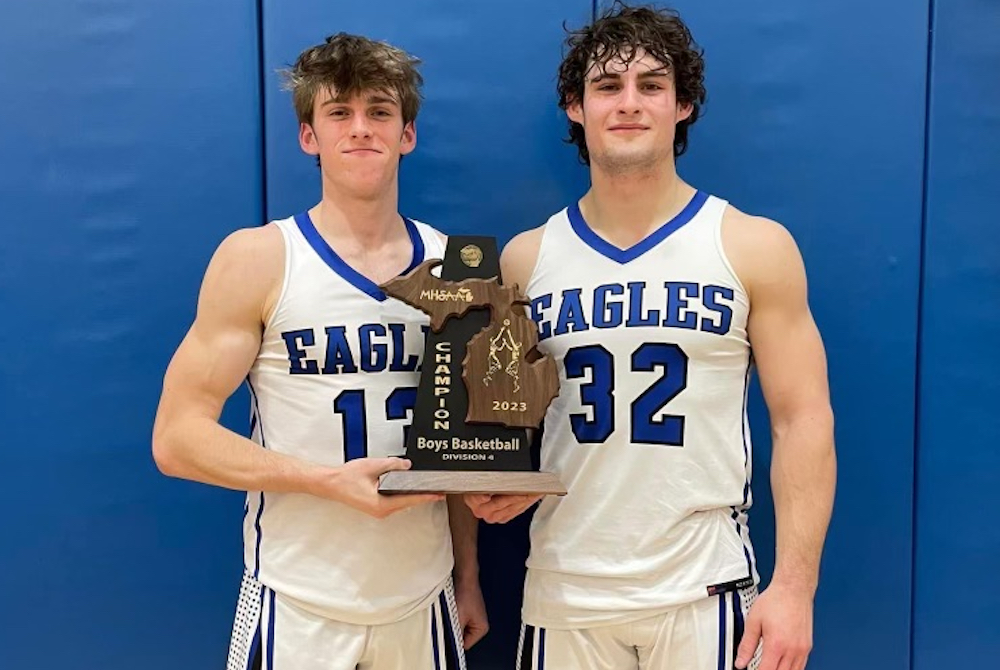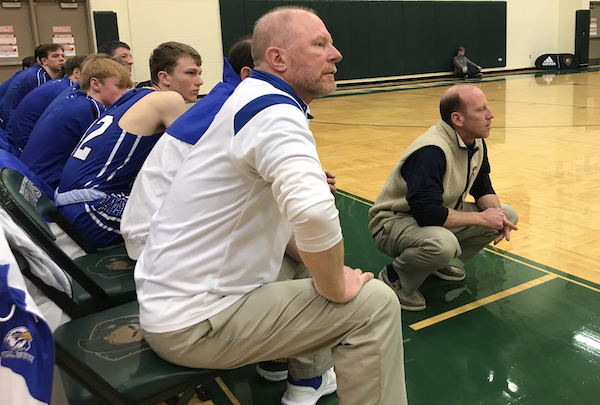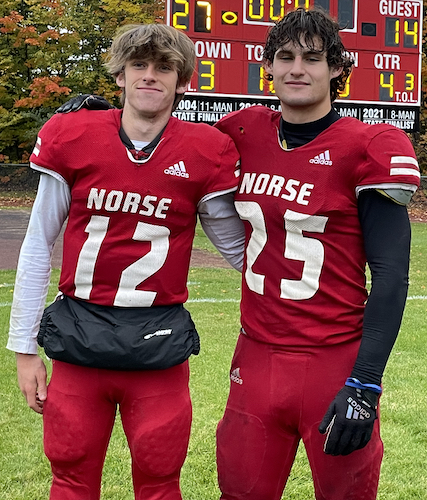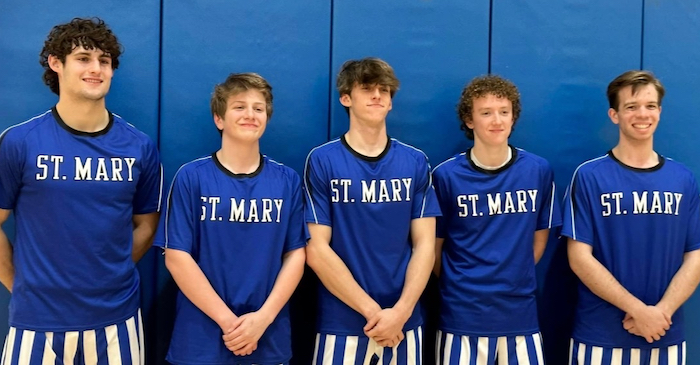
Inside Selection Sunday: Mapnalysis '15
October 26, 2015
By Geoff Kimmerly
Second Half editor
Consider that one hour Sunday night was the product of nine weeks of games on top of two more weeks of practice, hours of lifting weights, conditioning and camps and a total of six months of work at the MHSAA office, in addition to hours upon hours put in by athletic directors scheduling years in advance.
The anticipation for the release of another year's MHSAA Football Playoff pairings is matched by a giant exhale only after the results are broadcast on Fox Sports Detroit, streamed online and posted on locker room doors and Facebook walls all over our state.
 And then the fun begins again.
And then the fun begins again.
But the Selection Sunday Show is the favorite hour of the season for many fans across our state. And that’s why, for the fifth year, we’ll explain our most difficult decisions in this Mapnalysis 2015 breakdown of how we paired 272 teams that will play next month for championships across nine divisions.
For those familiar with our playoff selection process, or who have read this report in the past and don’t want a refresher on how we do what we do, skip the next section and go directly to the “Observations & Answers: 2015.” For the rest, what follows is an explanation of how we selected the playoff pairings during the morning hours Sunday, followed by how we made some of the toughest decisions and a few thoughts on the breakdown of the field.
Ground Rules
Our past: The MHSAA 11-player playoff structure – with 256 teams in eight divisions, and six wins equaling an automatic berth (or five wins for teams playing eight or fewer games) – debuted in 1999. An 8-player tournament was added in 2011, resulting in nine champions total each season.
The first playoffs were conducted in 1975 with four champions. Four more football classes were added in 1990 for a total of eight champions each fall. Through 1998, only 128 teams made the postseason, based on their playoff point averages within regions (four for each class) that were drawn before the beginning of the season. The drawing of Districts and Regionals after the end of the regular season did not begin until the most recent playoff expansion.
In early years of the current process, lines were drawn by hand. Dots representing qualifying schools were pasted on maps, one map for each division, and those maps were then covered by plastic sheets. Districts and Regionals literally were drawn with dry-erase markers.
Our present: After a late Saturday night tracking scores, we file in as the sun rises Sunday morning for a final round of gathering results we may still need (which can include making a few early a.m. calls to athletic directors). Re-checking and triple-checking of enrollments, what schools played in co-ops and opted to play as a higher class start a week in advance, and more numbers are crunched Sunday morning as the fields are set.
This season, there were a record-low 216 automatic qualifiers by win total – with the final 40 at-large then selected, by playoff-point average, one from each class in order (A, B, C, D) until the field was filled. There were only four Class D additional qualifiers with 5-4 or 4-4 (playing eight games) records from which we could choose – so after those four we added 12 teams each from Class A, Class B and Class C.
Those 256 11-player teams are then split into eight equal divisions based on enrollment, and their locations are marked on digital maps that are projected on wall-size screens and then discussed by nearly half of the MHSAA staff plus a representative from the Michigan High School Football Coaches Association. Only the locations themselves are marked (by yellow dots) – not records, playoff point averages or names of the schools or towns. In fact, mentions of those are strictly prohibited. Records and playoff points are not part of the criteria. Matchups, rivalries, previous playoff pairings, etc. also DO NOT come into play.
The same process is followed for organizing the 8-player bracket, with the difference that the 16 teams are selected purely on playoff-point average.
Geography rules: This long has been rule number one for drawing MHSAA brackets in any sport. Travel distance and ease DO come into play. Jumping on a major highway clearly is easier than driving across county-wide back roads, and that’s taken into consideration. Also, remember there’s only one Mackinac Bridge and hence only one way to cross between peninsulas – and boats are not considered a possible form of transportation. When opponents from both peninsulas will be in the same District, distance to the bridge is far more important than as the bird flies.
Tradition doesn’t reign: Every group of 32 dots is a new group – these 32 teams have not been placed in a bracket together before. How maps have been drawn in the past isn’t considered – it’s hard to say a division has been drawn in a certain way traditionally when this set of 32 teams is making up a division for the first time.
Observations & Answers: 2015
Go north with ease: For the most part, most Regional pairings were easier to draw than in past years. For the most part. Divisions 2 and 4 were not easy, specifically when it came to deciding which teams would be paired with an Upper Peninsula qualifier or a team from the Traverse City area. Keep in mind, distance on these maps isn’t based on how the bird flies, but how a bus would drive. In Division 2, that meant putting Muskegon, Muskegon Mona Shores and Grand Rapids Forest Hills Northern – near U.S. 31 and U.S. 131 – with Traverse City Central instead of sending Midland and Midland Dow west, up I-75 and then east-to-west again on more non-highway roads. In Division 4, we considered pairing Alma and Saginaw Swan Valley with Escanaba instead of Big Rapids and Remus Chippewa Hills. That decision came down to Big Rapids being about 14 miles closer to Escanaba than Swan Valley (Whitehall would go with Big Rapids and Chippewa Hills regardless.).
Four counties wide: Yes, on first glance it looks a little odd that Bay City John Glenn and Orchard Lake St. Mary’s would be in the same Division 3 District – but look at the map as a whole. Eight Division 3 teams are located south and mostly east of St. Mary’s, and John Glenn is the only team that could be considered in the northeastern quarter of the Lower Peninsula (Mount Pleasant and Gaylord are right down the middle and naturals to go with Sault Ste. Marie and Petoskey.). With the thumb playoff qualifiers of near-similar size in Division 4, there were no other options than to create this four-county trip between the Eaglets and Bobcats.
Semifinal selection: When all the Regional lines are drawn for a division, we also must figure out which Regionals will meet for Semifinals. This annually provides some challenges. Do we match east vs. west or north vs. south? If something seems iffy in four weeks when those games are played, again, keep in mind the entire map and entire Regionals that are matched up.
Scheduled strong: Because we’re looking only at dots on a map, we don’t see the matchups until everything is drawn – and in that way, we’re like everyone else. It wasn’t lost on us that two 9-0 teams will have road games this week or three 5-4 at-large qualifiers will be at home. For those 9-0 teams, it’s true: there’s nothing more they could’ve done on the field. But here’s why they will travel.
- Clinton, in Division 6, hasn’t lost a regular-season game since 2011, and in fact plays in a strong Tri-County Conference made up of Class C schools and one Class D. Four of eight from the league made the playoffs, and the competition was so strong that Morenci and Petersburg-Summerfield will host games in Division 8. But Clinton’s opponent, Monroe St. Mary Catholic Central, while it did have one loss, fell to one-loss Class B Lansing Catholic – and the Falcons played eight Class B and one Class A school this season. Beating a Class B team is worth 16 points more than beating a Class C and 32 more than beating a Class D (with those points then divided over the number of games a team plays that season) – and all of that made the difference in St. Mary’s final eight-point playoff average edge over Clinton.
- Saugatuck in Division 7 is a similar story. The Indians are one of three undefeated teams in their District, and did play a pair of Class B opponents. But by no fault of their own, especially in league play where the schedule is set, Saugatuck didn’t face a team this season that won more than five games. Hesperia played three Class B opponents including one that finished 6-3 – enough for the slim 1.8 points more in playoff average that earned the Panthers homefield advantage. Pewamo-Westphalia has the highest average in the District and didn’t play a Class B – the Pirates actually played three Class D teams. But they also beat four teams that made the playoffs including two that finished 8-1 – giving them a 2.7-point edge on Hesperia and 4.5 edge on Saugatuck.
- The 5-4 teams that will host – Redford Thurston in Division 3 and Escanaba and Benton Harbor in Division 4, all earned their spots. Escanaba faced six playoff teams and beat three, Class B Benton Harbor played eight Class A teams, and Thurston played five playoff teams and a sixth that just missed an at-large bid.
At the end of the day ...
What you see is what our committee decided upon after multiple discussions among multiple groups that broke down every sensible possibility we could muster. There are certainly points open to argument – and we likely made those arguments as well.
Those who would like to see the playoff selection process changed are in favor of a larger strength-of-schedule component, and it’s interesting to see how strength of schedule inadvertently made a larger impact this season than in the recent past – especially given the examples above of undefeated teams going on the road and at-large teams hosting.
Why were there fewer automatic qualifiers than ever before? Here's one theory. There were 11 fewer teams in 11-player football this season than in 2014 (most moved to 8-player). An argument can be made that there were fewer wins to be gained against teams that last season might have struggled to field 11-player teams, shifting the balance to fewer automatic qualifiers and more parity with stronger teams facing each other to fill their schedules.
Meanwhile, the 8-player field grew by nine teams this fall and has its strongest ever, with seven teams that finished 5-4 missing the postseason after a team with a sub-.500 record got in just a year ago.
Given how some matchups shook out this fall, the next argument by those seeking change likely will center on seeding entire Regionals instead of just Districts. But keep this in mind as well: if Regionals were seeded with this year's groupings, it would create possibilities of first-week trips like Battle Creek to Traverse City and Cedar Springs to Sault Ste. Marie. We're fairly sure most coaches and players would dread such journeys for a first-round game.
It's a lot to digest, and the scrutinizing will surely continue long after these playoffs are done as we all work to conduct the best tournament possible.
But at the end of the day – and the end of these next five weeks – to be the best, teams will need to beat the best no matter the matchups. And we’ve got plenty to look forward to starting this weekend and all the way through the 11-player Division 3 Final on Nov. 28 at Ford Field.
The MHSAA Football Playoffs are sponsored by the Michigan National Guard.
PHOTO: The Division 4 map was among the most difficult to draw during this year's selection process.

For Their Teams, For Each Other, St. Mary Seniors Team Up 2 More Times
By
Tom Spencer
Special for MHSAA.com
March 17, 2023
Shawn Bramer and Dylan Barnowski, as middle schoolers, attended the MHSAA Boys Basketball Finals every year.
 Last year, they nearly played in the Division 3 title game – falling in a Semifinal but almost making a dream come true for the then-juniors and their Lake Leelanau St. Mary coach, Matt Barnowski, also Dylan’s father.
Last year, they nearly played in the Division 3 title game – falling in a Semifinal but almost making a dream come true for the then-juniors and their Lake Leelanau St. Mary coach, Matt Barnowski, also Dylan’s father.
That dream began for some when the boys were coached by Matt as third graders, and they made serious strides last season. Before last winter, the last time the Eagles had won a Regional championship was 1950 – and no St. Mary boys basketball team had reached the Semifinals. Bramer and Dylan Barnowski – along with current seniors Jack Glynn, Drew Thompson and Nick Linguar – had high hopes of making more history this winter.
The dream ended Wednesday night with a Regional Final loss to Frankfort, which St. Mary had defeated 54-41 during the regular season. This time, the Eagles were faced with a large number of K-12 students succumbing to illness – with all five of its starters at least somewhat sick – as nearly a third of the school’s tiny enrollment was out of school the day after the loss to the Panthers.
But you won’t hear any of the players or coaches making excuses. They give all the credit to Frankfort, and they’re ready to move on. And many in the LSM family know reaching the Regional Finals this season and Breslin Center in 2022 had absolutely no probability had Bramer and Barnowski not made an iron-clad agreement last summer.
 The two friends vowed to help each other despite their personal, opposing challenges.
The two friends vowed to help each other despite their personal, opposing challenges.
Barnowski and Bramer, through LSM’s cooperative agreement with Suttons Bay, went 3-for-3 playing in 8-Player Division 1 Football Finals during their first three years of high school. But through last summer Barnowski, who quarterbacked the Norseman, had no interest in football.
Bramer, meanwhile, had been nursing a quad tendon injury since his sophomore football season and battling two bad knees but was thinking he could suffer though football and sit out the basketball season to recover. The all-state running back experienced training difficulties and even had his strength training severely hampered.
Football was king for Bramer, and he also loved basketball too. Basketball is number one to Barnowski. The longtime friends decided cut a deal to help each other — and their teammates — out.
“I was kind of on the edge,” said Bramer, who plays with braces on both knees. “After talking to each other, we both ended up just playing.
“I really shouldn’t be playing sports, but I couldn’t miss out playing with my friends,” he continued. “We just figured it was our last season so we might as well just do it.”
 Barnowski had been considering ending his football days immediately after the Norse fell short in their third-straight trip to the Finals, at Superior Dome in Marquette in Fall 2021. That loss was at the hands of Adrian Lenawee Christian 31-20.
Barnowski had been considering ending his football days immediately after the Norse fell short in their third-straight trip to the Finals, at Superior Dome in Marquette in Fall 2021. That loss was at the hands of Adrian Lenawee Christian 31-20.
The Norseman graduated most of their offensive and defense lines last spring and expected to be small in numbers. Until this fall, they had lost only one regular-season game on their way to three straight title game appearances. This year they finished 3-5.
The big linemen losses — Barnowski’s protection — was forcing him to weigh his injury risk against having a senior basketball season.
“We did it for each other,” Barnowski said. “I talked with Shawn, and we knew we had a big community behind us and it would be hard for them if we just quit.
“I knew we weren’t going to have the same powerhouse team we had,” he continued. “We weren’t very good this year, but we still had a blast.”
This week’s loss put an end to the possible Breslin championship finish, but it left the friends happy with the decision to play both sports. The Eagles finished 20-4.
Barnowski led St. Mary in scoring. He averaged better than 20 points a game with more than seven rebounds and five assists. Bramer averaged just under 15 points per game, and almost 10 rebounds.
The two big men each scored 11 in the season-ending loss. Thompson scored 14. This year’s senior-dominated team likely will be remembered for its basketball success for some time. Barnowski, Bramer and Glynn experienced only one loss in District play over their four seasons.
“It’s a really special groups of kids,” Coach Barnowski said. “These kids kind of transformed St. Mary’s basketball.
 “They’ve really built the program,” he continued. “It’s been a roller coaster ride.”
“They’ve really built the program,” he continued. “It’s been a roller coaster ride.”
Bramer and Dylan Barnowski also played baseball in the past for the Eagles, but that likely won’t happen this spring. Barnowski plans to golf, and Bramer expects to sit the spring season out and heal.
“We’ll never forget these last four years of varsity we played,” Barnowski said. “I‘ve decided to go a more relaxing route, and I’m going for some golf.”
With their Breslin dream over, the friends are ready to enjoy the St. Mary’s community support and move on. They’re bummed so many were sick in the end but won’t use it as an excuse.
“Hats off to Frankfort,” Barnowski said. “They did an incredible job of shutting us down.”
Bramer agreed.
“They just played their game better than we did,” he said. “They took the lead at the end of the third quarter, and it was a battle from there.”
 Tom Spencer is a longtime MHSAA-registered basketball and soccer official, and former softball and baseball official, and he also has coached in the northern Lower Peninsula area. He previously has written for the Saginaw News, Bay County Sports Page and Midland Daily News. He can be reached at [email protected] with story ideas for Manistee, Wexford, Missaukee, Roscommon, Ogemaw, Iosco, Alcona, Oscoda, Crawford, Kalkaska, Grand Traverse, Benzie, Leelanau, Antrim, Otsego, Montmorency, Alpena, Presque Isle, Cheboygan, Charlevoix and Emmet counties.
Tom Spencer is a longtime MHSAA-registered basketball and soccer official, and former softball and baseball official, and he also has coached in the northern Lower Peninsula area. He previously has written for the Saginaw News, Bay County Sports Page and Midland Daily News. He can be reached at [email protected] with story ideas for Manistee, Wexford, Missaukee, Roscommon, Ogemaw, Iosco, Alcona, Oscoda, Crawford, Kalkaska, Grand Traverse, Benzie, Leelanau, Antrim, Otsego, Montmorency, Alpena, Presque Isle, Cheboygan, Charlevoix and Emmet counties.
PHOTOS (Top) St. Mary’s seniors Dylan Barnowski, left, and Shawn Bramer hold up the team’s District championship trophy last week. (2) Eagles coach Matt Barnowski, center, and assistant Sander Scott coach up their team during last week’s Regional Semifinal win over Mesick. (3) Dylan Barnowski and Bramer also teamed up during successful football careers. (4) St. Mary’s seniors, from left: Shawn Bramer, Jack Glynn, Dylan Barnowski, Drew Thompson and Nick Linguar. (Sideline photo by Tom Spencer; player photos by Emmerson Lamb Photography.)

